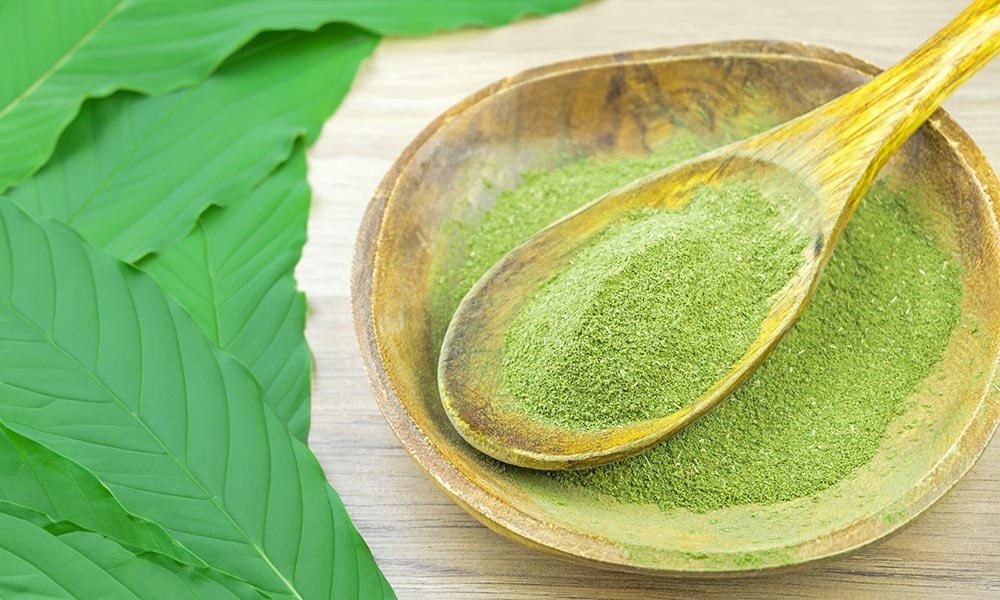Kratom is a tree that’s native to Southeast Asia, and it has become incredibly popular over the past several years for its unique ability to create stimulating effects and sedative effects, depending on the dose. With more and more people trying Kratom every day to self-manage pain, improve general mood, or reduce the severity of opioid withdrawal symptoms, getting a solid understanding of how long Kratom stays in your system is important.
What Is Kratom and Why Do People Use It?
Kratom is an herbal dietary supplement derived from the leaves of Mitragyna speciosa, a unique evergreen related to the coffee plant.[1] Kratom is used traditionally by those in Thailand and Indonesia, as the leaves contain multiple powerful alkaloids, the most notable of which are mitragynine and 7-hydroxymitragynine.
These interact with adrenergic receptors, serotonin receptors, and dopamine receptors in the brain, where at low doses of roughly 1 to 5 grams, kratom produces a notable stimulant-like effect that typically includes elevated energy, alertness, and sociability. At higher doses between 5 and 15 grams, however, the effects of kratom become more sedative, analgesic, and anxiolytic through the interactions with mu opioid receptors, similar to taking an opioid medication.
In recent years, it has become relatively common for consumers to turn to kratom to help manage chronic pain, improve mood and focus, and ease opioid withdrawal symptoms without relying on prescriptions or dealing with traditional opioids.[2]
Even though there is substantial anecdotal data touting the benefits of kratom, the FDA has not approved it for the treatment of anything and has raised concerns about its safety profile in general.
Kratom Pharmacology and Metabolism
Kratom has two primary active components, mitragynine and 7-hydroxymitragynine, which bind to both mu and delta-opioid receptors.[3] This is the primary mechanism that gives kratom its ability to produce euphoria and to modulate an individual’s perception of pain.
Additional secondary alkaloids like speciociliatine, paynantheine, and speciogynine all demonstrate synergistic effects that can contribute to kratom’s relatively complex pharmacological and safety profile.[4]
When ingested orally, mitragynine is first metabolized by the liver through enzymatic processes, which results in the mitragynine being split into multiple metabolites.[5] Some of these metabolites retain pharmacological action, while others are simply excreted through the kidneys and eventually appear in the urine.
Since much of the metabolism is done in the hepatic system, specific genetic polymorphisms can have a massive impact on the clearance of kratom.[6] Individuals who are poor CYP2D6 metabolizers will exhibit a far higher blood plasma concentration of mitragynine and a much slower clearance timeline. Conversely, inducers of CYP3A4 may accelerate kratom metabolism substantially, effectively reducing its half-life.
Once the kratom alkaloids have been metabolized, those metabolites then undergo renal excretion, so chronically dehydrated individuals, or those with reduced or impaired kidney function, will also see substantially longer clearance times.[7]
Since kratom isn’t generally part of a typical drug detection panel, specific liquid chromatography-tandem mass spectrometry (LC-MS/MS) assays are needed to verify the presence of mitragynine and other metabolites.
How Long Does Kratom Stay In Your System? Kratom Detection Windows By Test Type
Remember that since kratom isn’t included in the typical 5 or 10-panel drug test most commonly used, labs need to use specialized LC-MS or GC-MS testing methods to look for mitragynine and 7-hydroxymitragynine.
Urine
Urine is the most common method for detecting kratom alkaloids, and following a single low dose of 2 to 4 grams, metabolites are typically detectable in urine for up to 2–3 days, although in chronic users, detection may extend up to 5–7 days. Users who may be classified as chronic or high-dose individuals may accumulate metabolite levels that can be detected for as long as 5 to 7 days in the urine.[8]
Blood
Testing the blood plasma can capture much more recent kratom use, as after ingestion, mitragynine peaks in plasma in less than 2 hours, and has a half-life of 24 hours in most healthy adults. Detectable levels in blood will fall rapidly, often below assay thresholds, after just a few hours for light users.[9]
Saliva and Hair
Saliva testing for kratom is uncommon and not well validated; hair testing may theoretically detect kratom for extended periods, but standardized hair assays for kratom are not widely used or commercially available.[10]
Side Effects & Potential Risks of Kratom Use
While kratom is considered well-tolerated enough to be sold essentially over-the-counter, there are still some considerable side effects to be aware of.
The most common side effects include nausea, constipation, dry mouth, mild dizziness, and mild tachycardia. Higher doses can carry the risk of respiratory depression, which can be incredibly dangerous when coupled with the use of opioids, alcohol, or benzodiazepines.[11]
Gastrointestinal issues are also somewhat common, with prolonged use leading to persistent constipation.[12] There are also risks to the cardiovascular system, including increased blood pressure, hypertension, and arrhythmias in individuals who may have increased sensitivity to mitragynine. This can be more likely when consuming extremely high-potency kratom extracts.
Kratom also carries a definite risk of dependency and addiction.[13] Chronic, high-dose users will develop a tolerance to the opioid-like effects, leading to larger doses, and withdrawal symptoms when those doses are not maintained. Withdrawal symptoms can begin as early as just 12 hours after cessation, and can include irritability, sleep disruption, muscle aches, and increased agitation. More severe kratom addiction may see the detox stage include a risk of seizures or psychosis.
The FDA has also issued warnings about kratom’s safety, typically citing fatalities reported to have been linked to adulterated products or concomitant ingestion of opioids.[14]
Kratom Abuse, Dependency, and Withdrawal
The psychoactive effects of kratom can lead to escalating doses of kratom and, eventually, physical dependence, just like any other substance abuse or drug addiction issue. These effects make kratom highly attractive for drug use, and since it isn’t yet scheduled as a controlled substance by the Drug Enforcement Administration, it can be found in some of the most common places, like gas stations and tobacco shops.
Dependence develops as brain receptors adapt to regular exposure to a substance. Typical withdrawal symptoms manifest 12–48 hours after the last dose and include irritability, insomnia, muscle aches, restlessness, and a runny nose. In severe cases, users report anxiety, diarrhea, and nausea that mimic opioid withdrawal. Because kratom is not FDA-approved and lacks standardized dosing, the fluctuating brand quality and potencies can exacerbate the risks.
Treatment Options for Kratom Misuse
Safe kratom discontinuation will always use a gradual taper to minimize kratom withdrawal symptoms. Outpatient medication management services may be a good fit for a mild kratom addiction, where the daily dose is reduced by 10 to 20% each week, under medical supervision.
A core element of addiction treatment will rely on evidence-based therapies like cognitive behavioral therapy to help address the underlying mental health issues that caused the substance use. The Freedom Center provides individualized treatment plans that incorporate counseling, group therapy, and family support sessions to reinforce coping strategies and promote relapse prevention.
Healthcare providers collaborate with physical therapists to manage residual musculoskeletal pain through exercise and non-opioid pain relievers. Regular monitoring with drug tests ensures adherence, while personalized care addresses co-occurring mental health conditions that may jeopardize sobriety and resilience.












































